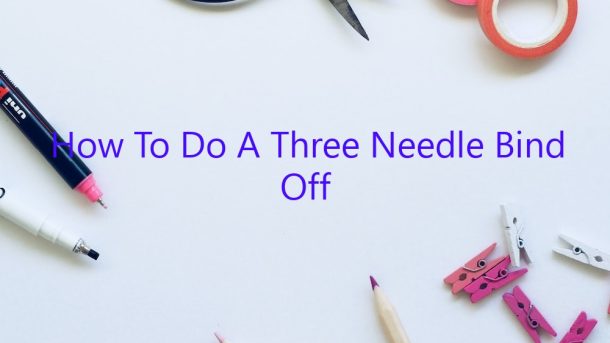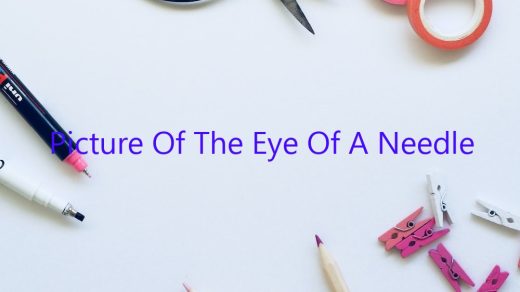A three needle bind off is a type of bind off used to join two pieces of knitting. It is worked by knitting the first stitch on one needle, then knitting the first stitch on the second needle. You then use the left needle to knit the first two stitches together, and then repeat this process until you have no stitches left on either needle.
The main benefit of using a three needle bind off is that it creates a very strong seam that is unlikely to come undone. It is also very easy to do, and can be used to join any type of knitting, including stockinette, garter, and ribbing.
Contents
How do I do a 3-needle bind off?
A three-needle bind-off, sometimes called a three-needle bindoff or a 3-needle join, is a technique for joining two pieces of knitting together. It is worked by inserting a needle into the first stitch on one piece of knitting and the first stitch on the other piece of knitting, then knitting them together.
To do a three-needle bind-off, you will need two pieces of knitting, a knitting needle the same size as the stitches on your knitting, and a tapestry needle.
1. With the two pieces of knitting facing each other, insert a needle into the first stitch on the front piece and the first stitch on the back piece.
2. Knit the two stitches together.
3. Repeat steps 1 and 2 until you have knit all the stitches together.
4. Cut the yarn, leaving a tail about 6 inches long.
5.Thread the tail onto a tapestry needle.
6. Pull the tail through the remaining stitch on the knitting needle.
7. Weave the tail in and trim it.
How much yarn do I need for 3-needle bind off?
When it comes to knitting, one of the most important things to know is how much yarn you will need for a project. This is especially true when it comes to techniques that use a lot of yarn, such as the 3-needle bind off.
So, how much yarn do you need for a 3-needle bind off? The short answer is that you need twice as much yarn as you would for a regular bind off.
The reason you need more yarn is that the 3-needle bind off creates a more sturdy seam than a regular bind off. This is because the bind off is reinforced by the stitches on either side of it.
If you are working with a particularly bulky yarn, you may need even more yarn than this. So, it is always best to err on the side of caution and overestimate how much yarn you will need.
In the end, the amount of yarn you need for a 3-needle bind off will depend on a number of factors, including the weight of the yarn, the size of the needles, and the gauge of the knitting.
So, how do you go about calculating how much yarn you will need for a 3-needle bind off?
There is no one definitive answer to this question. However, there are a few tips that can help you to get a ballpark estimate.
First, you need to determine how much yarn you will need for a regular bind off. To do this, you can use the following formula:
(yarn weight x number of stitches) / 10
Once you have this number, you need to double it. This is because you will be using two strands of yarn for the bind off, and you need to account for the fact that you will lose some yarn in the process.
So, for example, if you are using a worsted weight yarn and you are bind off 30 stitches, you would need (30 x 2) / 10 = 6 yards of yarn.
Of course, this is just a ballpark estimate. You may need more or less yarn depending on the project you are working on.
If you are working on a project that is particularly large or intricate, it is always best to err on the side of caution and knit a swatch to determine exactly how much yarn you will need.
In the end, the 3-needle bind off is a great way to create a strong, durable seam. With a little bit of practice, you will be able to master this technique and create beautiful, seamless knitted projects.
What does bind 3 mean in knitting?
What does bind 3 mean in knitting?
Bind 3 is a term used in knitting to indicate the number of stitches that need to be bound off. In order to bind off 3 stitches, you would knit two stitches, then use the knit two together (k2tog) stitch to bind them off.
How do you knit with 3 needles?
There are many ways to knit, and many ways to use different numbers of needles. If you’re interested in knitting with three needles, here is a quick tutorial on how to do it.
You’ll need a set of three double-pointed knitting needles, some yarn, and a knitting pattern. Cast on the required number of stitches onto one of the needles. Knit the first row, then knit the second row onto the next needle. You should now have one needle with all the stitches on it, and the other two needles should have no stitches on them.
Take the empty needle in your left hand and hold it like a pencil. With the working yarn still attached to the first stitch, use the right needle to knit the next stitch. Then use the left needle to pick up the stitch that was just knit and place it on the right needle.
Repeat this process until you reach the end of the row. Then, knit the next row in the same way. Be sure to keep an eye on your knitting to make sure you’re knitting the stitches in the correct order.
When you reach the end of the row, knit the last two stitches together. Then, knit the first stitch on the left needle together with the next stitch on the right needle.
Bind off the stitches in the usual way. Cut the yarn, leaving a tail long enough to weave in, and pull the tail through the last loop to fasten off.
How do you do a Russian bind off?
The Russian bind off is a way of binding off stitches in knitting that creates a neat, finished edge. It is a variation of the standard bind off, and is worked in a similar way, but with some key differences.
To do the Russian bind off, you will need a crochet hook that is the same size or smaller than the knitting needle you are using.
1. Insert the crochet hook into the first stitch on the knitting needle, and hook the yarn.
2. With the crochet hook still in the first stitch, pull the yarn through the stitch to the front of the work.
3. Insert the crochet hook into the next stitch on the knitting needle, and hook the yarn.
4. With the crochet hook still in the next stitch, pull the yarn through the stitch to the front of the work.
5. Repeat steps 3 and 4 until all the stitches have been bound off.
The Russian bind off creates a nice, finished edge, and is a great alternative to the standard bind off.
Is Kitchener stitch same as 3 needle bind off?
Kitchener stitch and 3 needle bind off are both techniques used to create a seamless, sturdy seam. They are both named after their inventors, Kitchener stitch after Lord Kitchener, and 3 needle bind off after its original developer, Elizabeth Zimmermann.
There are some differences between the two techniques, however. Kitchener stitch is a bit more complex, involving a series of steps to create the seam. 3 needle bind off is simpler and faster to execute, but is not as sturdy as Kitchener stitch.
Overall, the two techniques are quite similar and can be used interchangeably in many cases. Which one you choose to use is really a matter of personal preference.
How do you calculate yarn to bind off?
When binding off in knitting, you may need to know how much yarn to use. This calculation depends on the number of stitches you are binding off and the width of the yarn.
To determine how much yarn to use, measure the width of the yarn. Then, multiply this number by the number of stitches you are binding off. This will give you the total amount of yarn you need.




